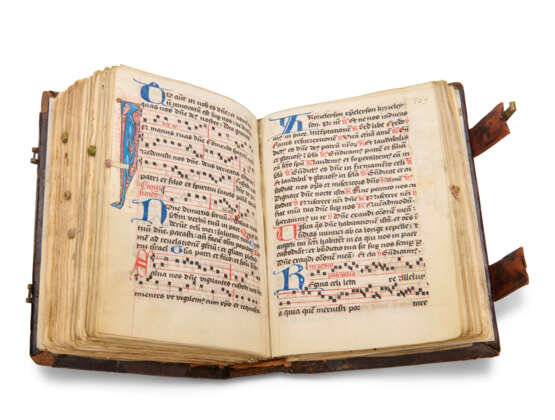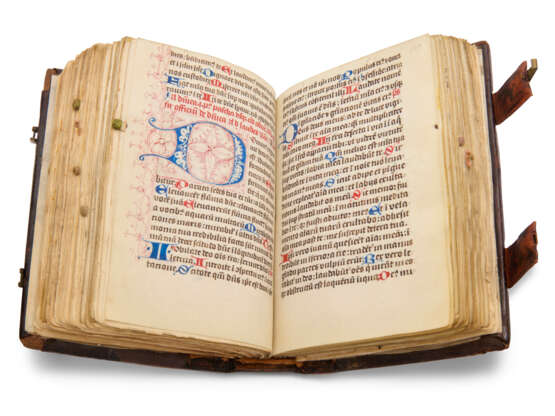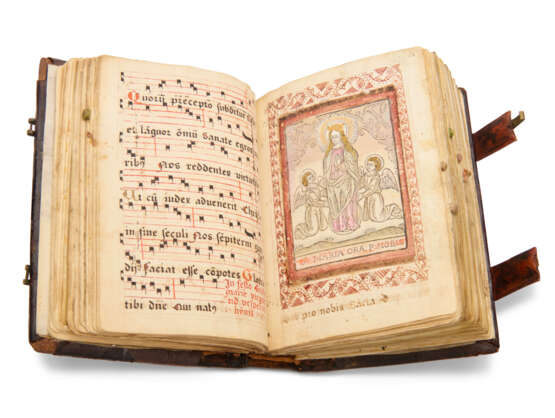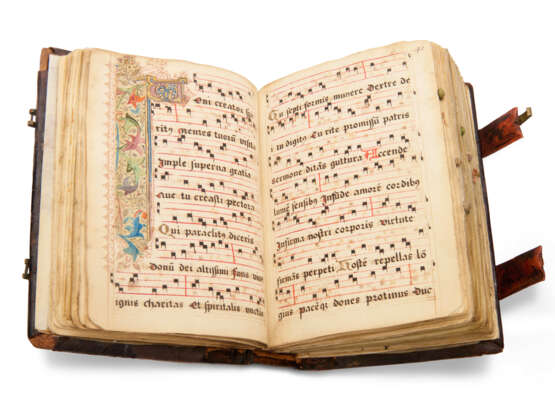ID 1450535
Lot 25 | A Franciscan noted Hymnal
Estimate value
£ 7 000 – 10 000
Noted Hymnal with liturgical texts, Franciscan use, in Latin and Dutch, decorated manuscript on paper and vellum with illuminated manuscript cuttings on vellum and three prints pasted in [Southern Netherlands, 16th to 17th centuries; illumination late 13th to 15th centuries]
Recycling and repurposing: a compilation with extensive musical notation embodying both the lives of Franciscan sisters and a significant aspect of the history of the book.
162 x 114 mm. i + 196 + i, exclusive of small insets, some loose, first foliation ff.1-171, apparently skipped from f.75 to f.78 (text continuous) but ff.76-77 possibly the paper bifolium renumbered ff.98 and 99, now placed after the first ff.98 and 99, which bear the same text, blank recto after f.100 unnumbered, lacking ff. 80, 131 and one leaf after f.153, ff.81-82 misbound after f.84, 19 leaves were left unfoliated after f.119, which were subsequently numbered ff.120-138, here as ff.120*-138*, by someone unaware that the first foliation continued after the new f.138* with f.120, eight unfoliated paper leaves were added after ff.34, 35 (two), 41, 56, 60 (two), 109; paper, except for ff.26-29, 97-111 (with paper inserts f.107 and as mentioned above), 118-119, 120*-138*, 120-154 on vellum, several alterations on paper pasted over original text and music; mostly six to nine four-line staves, ruled area varying c. 125 x 85 mm, ff.118-125 ruled for 24 lines, ruled space approx.135 x 85 mm, large initials in red or blue or a slightly metallic looking paint, some flourished in pink, 32 illuminated initials, most with border decoration, cut from manuscripts of the 13th to 15th centuries, and three prints, dating from c.1500 to the late 16th century, pasted in, often with additional flourishing (lacking at least three leaves from volume as bound, several texts incomplete probably because of leaves already missing, margins made up on first and last leaves, signs of use, border once pasted to f.4v loose in gutter, some pasted in elements lifting, some illumination smudged). c.1600 brown calf binding over wooden boards blind stamped with centre and corner pieces within framing of double fillets, spine in five compartments, two metal catches for two straps with metal hooks (rubbed, one hook lacking, straps possibly replaced, rebacked, new vellum endleaves and pastedowns).
Provenance:
The weight given to Franciscan feasts and the mention of the order, f.47v, shows that the book was made for, and almost certainly in, a Franciscan house. The hymns for the Franciscan St Didacus, ff.114-117v, are unlikely to have been written much before his canonisation in 1588, dating the compilation of the volume to the 1590s. The lengthy texts devoted to St Clare indicate that this was a female community, a provenance supported by the sometimes uncertain Latin of the later sections. Some of the rubrics are in Dutch and the Latin orthography at times reveals a Dutch speaking scribe, as in schripsit for scripsit, small insert after f.79. The community evidently had a collection of manuscripts that could provide useful texts or, if outdated after the reforms of the Council of Trent, could be quarried for their illumination.
The flourished decoration of the pre-existing principally textual section, perhaps of the decades around 1500, is Southern Netherlandish in style, e.g. f.118v; many of the reused borders are in a style associated principally with Bruges and Ghent in the second half of the 15th century. By the date of the volume’s compilation, not to mention the latest 17th-century additions, a Dutch speaking convent was unlikely still to be functioning in the Northern Netherlands. There were numerous Franciscan houses in the Southern Netherlands, where the lives of many communities had been disrupted by iconoclasm and warfare in the opening decades of the Eighty Years’ War: the volume may mark the resumption of a more settled life and the need to replace destroyed or plundered possessions. What could be salvaged from the past could be combined with the sisters’ own work, itself a meritorious undertaking, to replenish the stock of books.
Content: antiphons, f.1 and small insert; hymns from Advent to Easter, including after the Epiphany (6 January) the name of Jesus, f.16, observed by the Franciscans from 1530 on 14 January, ff.2-25v, Te deum and hymn for Saturday before Easter lacking end ff.26-29v; hymns for Easter to Corpus Christi, continuing with Sanctoral hymns from f.63v, including the Franciscans Antony of Padua f.68v, Clare with octave, ff.81-92, stigmatisation of Francis ff.91v-93v, Francis with octave on vellum, ff.98-108, with ff.99-106 and 108 on vellum, given continuous text with the adjacent leaves by text on paper pasted over part of ff.97, 106v and 108, Didacus ff.114-117v; psalms without musical notation with antiphons, response and versicles, lacking opening before the Te deum f.118, for the office from the Sunday after Easter to Advent, with some music from f.138v*, including antiphons for Sts Francis and Clare ff.129-130v, from f.133v the content is again all noted, that for All Saints lacking end, f. 156v, a partial communal opens f.157v, ending with the dedication of a church f.171v.
This complex compilation requires detailed analysis of the different hands, sections and adaptations. It consists of existing sections of text, not all complete, brought together with leaves apparently specially written in the late 16th century, which were carefully integrated with paper paste overs to provide continuous text. Further inserts and corrections continued to be made in the 17th century, making the book an intriguing example of changing liturgical practice as well as of amateur book production within a Franciscan house.
Decoration and Illumination:
The texts are simply decorated, the most elaborate having letters flourished in a Southern Netherlandish style of around 1500, e.g. f.118v. Later a less skilled hand provided flourishing around some of the pasted in borders and initials; there are also penwork borders around the pasted in prints.
The reusing of earlier illuminations is a practice that was not unusual and that continued through the centuries. There is a roughly contemporary example from the Southern Netherlands in the Fitzwilliam Museum, Cambridge: an antiphonary from a house of Augustinian canons with pasted in illuminations from the 14th and 15th centuries (N. Morgan and S. Panayotova eds, A Catalogue of Western Book Illumination in the Fitzwilliam Museum and Cambridge Colleges, Part I, vol II, The Southern Netherlands, 2009, no 252). The earliest manuscript available to the Franciscan sisters could be late 13th century, ff.2 and 126v; some cuttings, as on f.127v look to be from the 14th century. Most of the borders seem to have come from one 15th-century manuscript, probably also the source of many initials. A great deal of trouble was taken in excising and securing often quite small elements: on f.91v, thin line endings have been carefully glued around the pasted in initial.
Prints had long been added to manuscript, particularly in religious houses where illuminating skills might not run to figurative miniatures. The earlier function of the three prints available for the hymnal is not known. The differences in palette suggest that they had already been coloured.
The earliest is probably the engraving placed on f.157 before the hymn for the common of an apostle. The Instruments of the Passion surround a rosary where the decades are marked by Christ’s wounded heart, hands and feet. Within the rosary, the roundels of apostles, Paul with Peter and Andrew with Bartholomew, are reversed versions of two of the forty-eight roundels, issued on six sheets by Israhel van Meckenem probably in the 1480s (Lehrs 445-452). The developed rosary indicates a date closer to 1500. For van Meckenem's original roundels being pasted into manuscripts, see K. Rudy, Image, Knife and Gluepot: Early Assemblage in Manuscript and Print, 2019.
The 16th-century cut of the Assumption of the Virgin supported by two angels, with stone masons’ tools in the spandrels of the framing arabesques, f.62, precedes hymns favoured for the Purification of the Virgin, f.62v, although headed simply as ‘feast of the Virgin’. The print was possibly based on a cult image within a masons’ chapel.
The late 16th-century engraving of the Adoration of the Host by angels, f.52, precedes the hymn for the feast of Corpus Christi.
| Place of origin: | Western Europe, Europe, The Netherlands |
|---|---|
| Auction house category: | Medieval & renaissance manuscripts, Books and manuscripts |
| Place of origin: | Western Europe, Europe, The Netherlands |
|---|---|
| Auction house category: | Medieval & renaissance manuscripts, Books and manuscripts |
| Address of auction |
CHRISTIE'S 8 King Street, St. James's SW1Y 6QT London United Kingdom | |
|---|---|---|
| Preview |
| |
| Phone | +44 (0)20 7839 9060 | |
| Buyer Premium | see on Website | |
| Conditions of purchase | Conditions of purchase |







